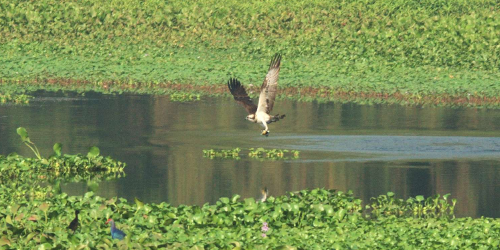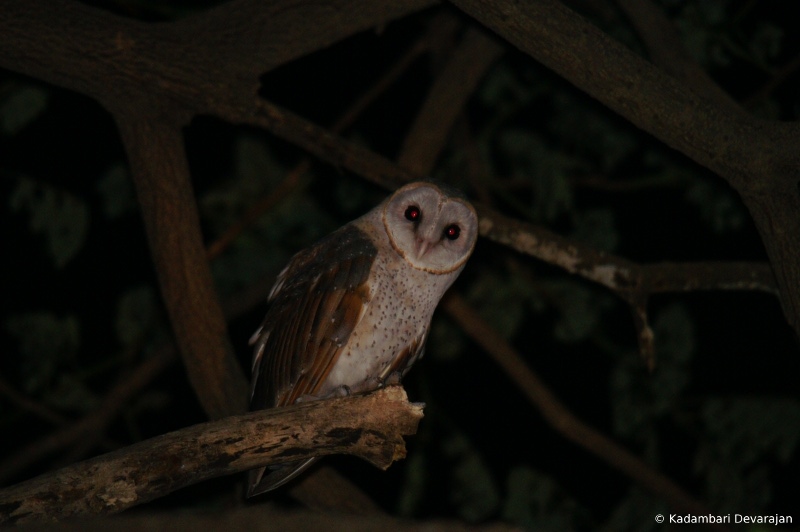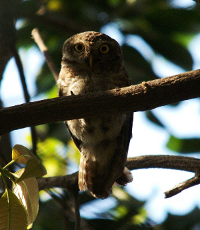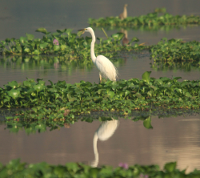The Wildlife of IIT Bombay
I live inside the IIT Bombay campus. And, consider myself privileged to stay there - a little haven within the bustling metropolis of Mumbai, a tiny island (metaphorically speaking) that is cut off from the city's concrete jungle, fumes, pollution, famed commutes, and crowds. It is nicely ensconced between the breathtaking (and crocodile infested) Powai lake on one side and a hillock worthy of picnics on the other. What's more, it shares borders with the Sanjay Gandhi National Park - one that the numerous residents of the park frequently disregard! There are even notices warning folks to not venture into certain areas that are prone to, say, a stray leopard that wandered in from its home adjoining the campus :) During the rains, tracts transform into mini rainforests - replete with Rhesus Macaques and Grey Hornbills.

An osprey (Pandion haliaetus) with fish in its talons, breakfast at the Powai Lake ...
Mumbai itself is a rather interesting city. It sits jutting into the Arabian Sea, which will explain the high humidity of the region, and thanks to the undulating terrain and heavy monsoons plays host to a good variety of fauna. One can find many hills worthy of treks, ranging from the easy to those that are considered precursors to Himalayan expeditions, many within an hour's drive from the city. During the monsoon, the suburbs don a green blanket, and waterfalls erupt out of any rock possible. The 400 or so forts in the vicinity (right upto the Konkan coast in Goa), many built by Chhatrapati Shivaji, are good places to go on treks (and get a taste of history and folklore). The monsoon is considered a good time of the year to go trekking, especially since the rain is a refreshing drizzle when compared to the sultry humidity of the other significant portion of the year - summer. Adventure sports have also been gaining momentum in the area - and for the adventurous, waterfall rappelling during the monsoon should be a definite try. One does everything one does in the 'usual' rappelling, with the addition of going down a waterfall, frequently WHILE it is raining! The adrenaline rush of going down a 150 ft waterfall while it's pouring cats and dogs, and savoring the view from the middle, is heady! The combination of the sea coast with hills and forests ensures good resident and migrant populations of avifauna. Water birds, waders, forest dwellers, etc., can all be found in or near the city.

A Barn Owl (Tyto alba) on the hillside area
Mammals that I have seen in the campus include:

Mongoose, Indian Grey (Herpestes edwardsii)
Flying Fox, Indian (Pteropus giganteus)
Langur, Gray (Semnopithecus entellus)
Macaque, Rhesus (Macaca mulatta)
Mongoose, Ruddy (Herpestes smithii)
Pangolin, Indian (Manis crassicaudata)
Rat, Brown (Rattus norvegicus)
Rat, Lesser Bandicoot (Bandicota bengalensis)
Squirrel, Three-striped Palm (Funambulus palmaram)
Reptiles seen include:
Bengal Monitor Lizard (Varanus bengalensis)
Garden Calotes (Calotes versicolor)
Marsh Crocodile (Crocodylus palustris)
Green Vine Snake (Ahaetulla nasuta)
Rat Snake (Ptyas mucosus)
The following is a list of the birds I have seen inside the IIT Bombay campus.
|
 Spotted Owlet |
 Intermediate Egret |
Total - ~85
Checklists
Reptiles of IIT Bombay
Calotes, Garden (Calotes versicolor)
Calotes, Forest (Calotes rouxii)
Cobra, Spectacled (Naja naja)
Crocodile, Marsh (Crocodylus palustris)
Gecko, Brook's (Hemidactylus brookii)
Keelback, Checkered (Xenochrophis piscator)
Monitor, Bengal (Varanus bengalensis)
Snake, Rat (Ptyas mucosus)
Snake, Green Vine (Ahaetulla nasuta)
Skink, Brahminy (Mabuya carinata)
Viper, Russell's (Daboia russelii)
Total - 11
Mammals of IIT Bombay
Flying Fox, Indian (Pteropus giganteus)
Hare, Black-naped (Lepus nigricollis)
Langur, Gray (Semnopithecus entellus)
Macaque, Rhesus (Macaca mulatta)
Mongoose, Indian Grey (Herpestes edwardsii)
Mongoose, Ruddy (Herpestes smithii)
Pangolin, Indian (Manis crassicaudata)
Rat, Brown (Rattus norvegicus)
Rat, Lesser Bandicoot (Bandicota bengalensis)
Squirrel, Three-striped Palm (Funambulus palmaram)
Total - 10
The Birds of IIT Bombay
Avadavat, Red
Babbler, Yellow-eyed
Babbler, Jungle
Babbler, Tawny-bellied
Barbet, Brown-headed
Barbet, Coppersmith
Bee-eater, Blue-tailed
Bee-eater, Small Green
Bulbul, White-cheeked
Bulbul, Red-vented
Bulbul, Red-whiskered
Bulbul, White-browed
Cisticola, Zitting
Coot, Common
Cormorant, Little
Coucal, Greater
Cragmartin, Dusky
Crow, House
Crow, Large-billed
Cuckoo, Common Hawk
Cuckoo, Pied Crested
Cuckooshrike, Black-headed
Darter, Oriental
Dove, Emerald
Dove, Spotted
Dove, Eurasian Collared
Drongo, Ashy
Drongo, Black
Duck, Comb
Duck, Lesser Whistling
Duck, Spot-billed
Egret, Cattle
Egret, Intermediate
Egret, Little
Flowerpecker, Thick-billed
Flycatcher, Asian Paradise
Flycatcher, Black-naped Monarch
Flycatcher, Brown
Flycatcher, Red-throated
Flycatcher, Tickell's Blue
Flycatcher, White-browed Fantail
Godwit, Black-tailed
Grebe, Little
Harrier, Western Marsh
Heron, Black-crowned Night
Heron, Grey
Heron, Indian Pond
Heron, Purple
Hoopoe, Common
Hornbill, Indian Grey
Ibis, Black-headed
Ibis, Glossy
Iora, Common
Jacana, Bronze-winged
Jacana, Pheasant-tailed
Kestrel, Common
Kingfisher, Common
Kingfisher, Pied
Kingfisher, White-breasted
Kite, Black
Kite, Brahminy
Koel, Asian
Lapwing, Red-wattled
Moorhen, Common
Munia, Scaly-breasted
Myna, Common
Nightjar, Indian
Oriole, Golden
Osprey
Owl, Barn
Owl, Collared Scops
Owlet, Jungle
Owlet, Spotted
Parakeet, Alexandrine
Parakeet, Plum-headed
Parakeet, Rose-ringed
Peafowl, Indian
Pigeon, Rock
Pipit, Paddyfield
Pitta, Indian
Prinia, Ashy
Prinia, Plain
Robin, Indian
Robin, Oriental Magpie
Roller, Indian
Sandpiper, Common
Sandpiper, Wood
Shelduck, Ruddy
Shikra
Shrike, Grey
Shrike, Long-tailed
Snipe, Common
Snipe, Greater Painted
Sparrow, House
Starling, Asian Pied
Starling, Brahminy
Starling, Chestnut-tailed
Stilt, Black-winged
Stonechat, Common
Stork, Asian Open-billed
Sunbird, Purple-rumped
Sunbird, Purple
Swallow, Barn
Swallow, Wire-tailed
Swallow, Red-rumped
Swamphen, Purple
Swift, Asian Palm
Swift, House
Tailorbird, Common
Tern, Black-bellied
Tern, Little
Tern, Whiskered
Thrush, Orange-headed
Wagtail, Grey
Wagtail, White
Wagtail, White-browed
Wagtail, Citrine
Warbler, Ashy Wren
Warbler, Booted
Warbler, Syke's
Warbler, Greenish
Warbler, Blyth's Reed
Waterhen, White-breasted
Weaver, Baya
Woodpecker, Rufous
Woodpecker, Black-rumped Flameback
Total - ~130